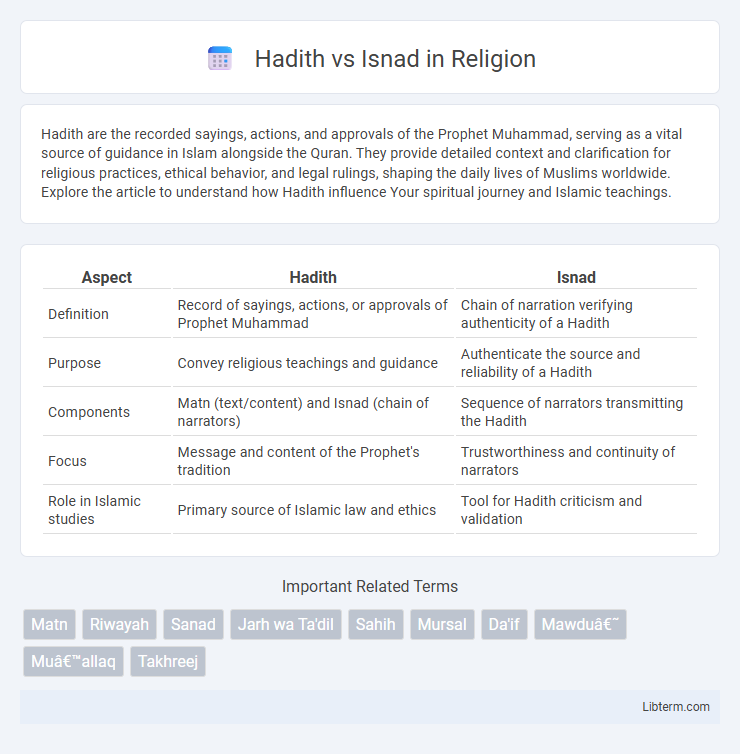Hadith are the recorded sayings, actions, and approvals of the Prophet Muhammad, serving as a vital source of guidance in Islam alongside the Quran. They provide detailed context and clarification for religious practices, ethical behavior, and legal rulings, shaping the daily lives of Muslims worldwide. Explore the article to understand how Hadith influence Your spiritual journey and Islamic teachings.
Table of Comparison
| Aspect | Hadith | Isnad |
|---|---|---|
| Definition | Record of sayings, actions, or approvals of Prophet Muhammad | Chain of narration verifying authenticity of a Hadith |
| Purpose | Convey religious teachings and guidance | Authenticate the source and reliability of a Hadith |
| Components | Matn (text/content) and Isnad (chain of narrators) | Sequence of narrators transmitting the Hadith |
| Focus | Message and content of the Prophet's tradition | Trustworthiness and continuity of narrators |
| Role in Islamic studies | Primary source of Islamic law and ethics | Tool for Hadith criticism and validation |
Introduction to Hadith and Isnad
Hadith refers to the recorded sayings, actions, and approvals of the Prophet Muhammad, serving as a fundamental source of Islamic law and guidance alongside the Quran. Isnad is the chain of narrators who transmitted the Hadith, providing authentication and credibility to each tradition. The science of Hadith classification relies heavily on Isnad analysis to distinguish authentic (Sahih), good (Hasan), and weak (Da'if) narrations.
Defining Hadith: Meaning and Components
Hadith refers to the recorded sayings, actions, and approvals of the Prophet Muhammad, serving as a crucial source for Islamic teachings alongside the Quran. It consists of two main components: the matn (text), which contains the actual content or message, and the isnad (chain of transmission), which lists the series of narrators who transmitted the hadith. The authenticity and reliability of a Hadith heavily depend on the strength and continuity of its isnad, ensuring accurate preservation of the Prophet's teachings.
Understanding Isnad: The Chain of Transmission
Isnad refers to the chain of transmission that authenticates a Hadith by tracing the lineage of narrators back to the Prophet Muhammad. Each individual in the Isnad is scrutinized for trustworthiness and accuracy, ensuring the reliability of the Hadith's content. Understanding Isnad is essential for Islamic scholars to determine the Hadith's legitimacy and establish its use in religious doctrine.
The Role of Isnad in Authenticating Hadith
Isnad plays a critical role in authenticating Hadith by providing the chain of narrators who transmitted the Prophet Muhammad's sayings and actions. Each link in the isnad is meticulously examined for reliability, integrity, and continuity to ensure the Hadith's credibility. This systematic scrutiny distinguishes authentic Hadith from fabricated or weak narrations, preserving the integrity of Islamic teachings.
Key Differences Between Hadith and Isnad
Hadith refers to the recorded sayings, actions, and approvals of the Prophet Muhammad, serving as essential sources of Islamic law and guidance. Isnad is the chain of narrators who transmit the Hadith, critical for verifying the authenticity and reliability of each narration. The key difference lies in Hadith being the content or text itself, while Isnad represents the methodology and evaluation system ensuring the Hadith's credibility.
Historical Development of Hadith and Isnad
The historical development of Hadith and Isnad is integral to the preservation of Islamic teachings, with Hadith referring to the recorded sayings and actions of Prophet Muhammad and Isnad denoting the chain of narrators verifying the Hadith's authenticity. Early Islamic scholars meticulously documented Isnad to establish the reliability of each narrator, which became a cornerstone in Hadith sciences enabling the classification of traditions into Sahih (authentic), Hasan (good), and Da'if (weak) categories. This rigorous methodology developed during the 8th and 9th centuries CE, forming the foundation for canonical Hadith collections like Sahih Bukhari and Sahih Muslim.
Criteria for Evaluating Isnad
The criteria for evaluating Isnad involve assessing the reliability, continuity, and integrity of the chain of narrators transmitting a Hadith. Scholars examine each narrator's honesty, memory precision, and direct contact with the preceding narrator to ensure authenticity. Rigorous scrutiny of Isnad ensures that the Hadith remains credible and free from fabrication or distortion.
Common Misconceptions About Hadith and Isnad
Many mistakenly believe Hadith and Isnad are synonymous, when Hadith refers to the actual sayings or actions of the Prophet Muhammad, and Isnad is the chain of narrators verifying the Hadith's authenticity. Another common misconception is that a weak Isnad invalidates the entire Hadith, although scholars may still consider its content for jurisprudential insights if the text aligns with established principles. Understanding the distinction between Hadith as the message and Isnad as its authentication chain is crucial for accurate Islamic scholarship and proper evaluation of prophetic traditions.
The Impact of Isnad on Islamic Scholarship
Isnad, the chain of transmission in Hadith literature, serves as a critical tool for verifying the authenticity and reliability of prophetic traditions, profoundly shaping Islamic scholarship. By meticulously analyzing each narrator within the isnad, scholars establish classification systems like Sahih (authentic) and Da'if (weak), which influence the application of Hadith in jurisprudence and theology. The rigorous science of isnad criticism underpins the credibility of Hadith compilations such as Sahih Bukhari and Sahih Muslim, reinforcing foundational Islamic law and doctrine.
Conclusion: The Interdependence of Hadith and Isnad
Hadith and Isnad are fundamentally interdependent, with Hadith representing the Prophet Muhammad's sayings or actions and Isnad constituting the chain of reliable narrators verifying authenticity. The strength of any Hadith relies on the integrity of its Isnad, as a weak or broken Isnad can render the Hadith unreliable or fabricated. Scholars stress that effective Islamic jurisprudence and theology depend on rigorous evaluation of both Hadith content and Isnad authenticity to preserve doctrinal accuracy.
Hadith Infographic

 libterm.com
libterm.com